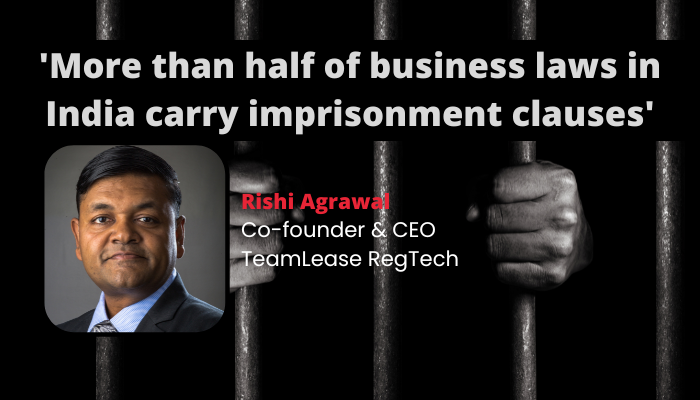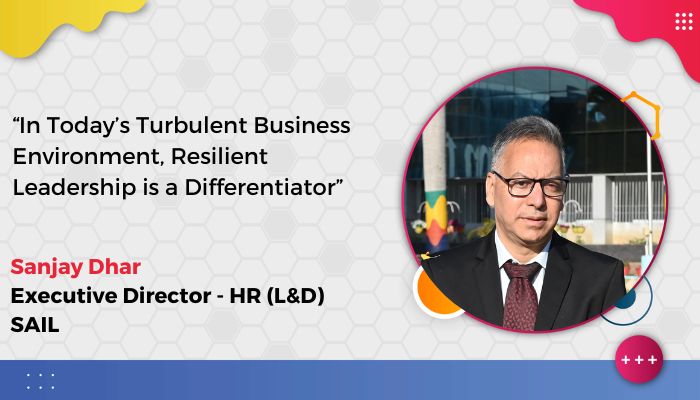Rishi Agrawal, Co-founder and CEO, TeamLease RegTech, stresses on the cost of poor compliance management practices and how half of business laws in India carry imprisonment clauses. He jots down five effective ways through which employers can enhance visibility and control over their compliances.
The regulatory universe for employers is complex. There are 1,536 laws that govern doing business in India, consisting of 69,233 compliances and 6,618 annual filings. Staying on top of these statutory requirements is an onerous task. The compliance burden becomes more intricate as employers expand their geographic footprint, operations and headcount.
At the same time, the cost of poor compliance management practices has escalated over the years. More than half of business laws in India carry imprisonment clauses. Two out of every five compliances impose a jail term for violation. Inadvertent lapses and procedural defaults can have severe penal consequences for employers. It can also harm the revenue stream, growth potential and public reputation of their business. With the government ramping up its digital capacities for detecting delays, evasion and omissions, there is no room for compliance errors.
The ramifications of poor compliance underscore the need for a comprehensive compliance management system. Employers must shift from ad-hoc and manual compliance processes to pave way for smart and automated compliance solutions. Such a transition will bring about transparency and accountability and reduce non-compliance. Given below are five effective ways through which employers can enhance visibility and control over their compliances.
Understanding Compliance Requirements
More often than not, poor compliance management practices stem from the lack of a steady grasp on the wide spectrum of compliances. These include approvals, certifications, licenses, permissions, consent orders, challans, payments, displays, registers and returns, among many others. It is estimated that over 90% of employers in India do not have a clear picture of their compliance needs. To stay compliant, it is crucial for employers to integrate systems that help gauge the extent of their regulatory ecosystem.
Staying Updated on Regulatory Changes
The compliance universe is dynamic, with an average of 10 regulatory changes per day. In 2021 alone, there were as many as 3,577 updates in the compliance requirements. On top of this, there is no single point of information for tracking these updates. Currently, the regulatory changes are notified on 2,000+ central, state and local government websites. To prevent any compliance slip-ups, employers must develop the necessary capacities to stay up-to-date on the latest regulatory changes.
Fostering a Culture of Compliance
The onus of compliance should not fall on the shoulders of a particular individual. Rather, efforts should be made to establish collective responsibility across the organisation with overall supervision by the compliance officer. To this end, compliance tasks should be decentralised and each stakeholder should be made aware of their respective responsibilities. Coordination among all stakeholders must be ensured through robust compliance processes at all levels and departments. Period assessments, risk evaluation, and corrective interventions should form the focal points of the compliance strategy. Good compliance behaviour must be incentivised within the organisation.
Creating a Central Compliance Document Repository
Paperwork and documentation have become synonymous with compliance. Most compliances today involve a slew of applications, forms, receipts and acknowledgements, with multiple copies of each document. Given the sheer amount of paperwork, employers must adopt a systematic approach to manage the life cycle of these critical documents. To this end, a central repository of all compliance paperwork can be created with digital, verified and tamper-proof copies of each document. It can serve as a nodal point for all working files as well. Overall, the repository can help save time, energy and resources, thereby allowing compliance officers to focus on other high priority tasks.
Going Digital
As the organisation grows, the compliance obligations increase exponentially. Ad-hoc, manual and people-based compliance processes fail to scale and often generate poor outcomes. In wake of the tech revolution, employers must embrace the benefits of digitisation. Digital compliance softwares incorporate features such as dynamic workflows, automated alerts and reminders, timely reports, periodic updates and paperless repositories, among others, to facilitate ease of compliance. The switch to digital compliance management can help employers achieve accurate, transparent and timely compliance.
The impact of a robust compliance system can be felt across an organisation. Strengthening compliance management practices through the lens of digitisation and innovation should assume top priority for employers.
Rishi Agrawal is Co-founder and CEO at TeamLease RegTech. He is a passionate technology entrepreneur who believes in the potential of technology to transform human lives. Over the past few years, Rishi has been working on developing a regulatory technology platform to automate and simplify India’s complex compliance environment. He has worked with over 1,000 organisations (Enterprises & MSMEs) across 40 Industries in India helping them through their compliance management journey. He deeply understands the complexity of managing compliances across central, state and local governments. He has been partnering with corporate India, industry bodies and think-tanks to enable Compliance 3.0. He created the four vector framework of rationalisation, simplification, digitisation and decriminalisation. Rishi served as an advisor to the WGOM (Working Group of Ministers), works closely with several ministries, DPIIT, Invest India and World Bank on various ease of doing business initiatives. He is also a member of CII Taskforce for Ease of Doing Business. Rishi frequently writes in ORF (Observer Research Foundation), Financial Express, India Today, Mint among others.






